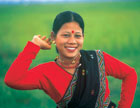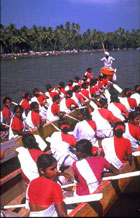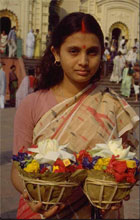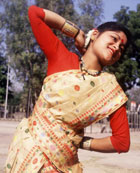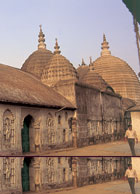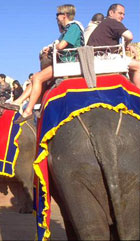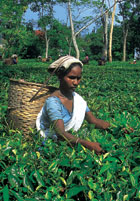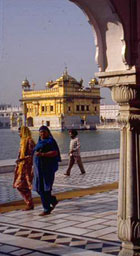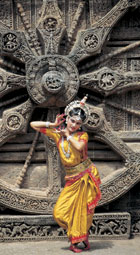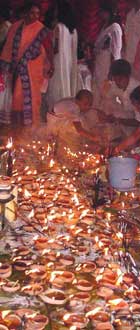Wahid Saleh
It is difficult to determine when the Indians started their emigration to the Netherlands. A Dutch TV programme on Azad Hind Brigade stationed in German-occupied Holland mentioned that a brigade of Sikhs arrived in German-occupied Holland back in June of 1943. The so-called ‘Azad Hind Brigade’ or ‘Fries Indien’ had been formed on instigation of Netaji Subash Chandra Bose, following a meeting with Hitler. According to this documentary 10,000 Indian soldiers fighting with/for the British in North Africa were captured by the Germans and later imprisoned in Germany. When Mr Bose came to meet Hitler, hoping to enlist his efforts to liberate India from the British, he suggested that the imprisoned Indian soldiers could be roused to join the Germans in their fight against the Allies.
Ultimately, some 3000 did in fact join. They were trained in Dresden. The Indian soldiers, welded into the Azad Hind Brigade were deployed on Holland’s North Sea coast – Zandvoort and Texel.
The departure of the Indians from the Netherlands was as sudden as their arrival had been. The entire Brigade was transferred to southern France. No satisfactory explanation was ever given, but it is speculated that the Dutch climate did not agree with the Indians and/or the Germans wanted to end any fraternising between the Indians and the Dutch locals [1].
In any case the emigration of Indians to the Netherlands is a post-World War II phenomenon.
At present The Netherlands has the second largest population of people of Indian origin in Europe.[2] There are two very distinct groups among the Indian community in the Netherlands.- the People of Indian origin (PIO) whose roots are mainly in UP and Bihar and the NRIs.
The first group of 399 Indians sailed from Kolkatta in the boat 'Lalla Rookh’ and arrived in the then Dutch colony of Suriname on 5th June 1873. Between 1873 and 1916 about 34.000 Indians migrated to Surinam. About 11.000 of them returned to India. They came to Surinam under the indenture system.[3]
Most Hindustanis from Surinam migrated to the Netherlands when Surinam became independent in 1975. Before the independence of Surinam, the main motivation for Hindustanis to migrate to the Netherlands was the increased opportunities of higher education as compared to Surinam.[4]
In more recent years Indians from India joined them. The Netherlands has a total population of about 16, 3 million,[5] out of which the PIOs (Surinamese Indians - Sarnami Hindustanis as they call themselves) are about 160,000 in number. It is estimated that there are about are about 15,000 – 20.000 Indians including between 1,000 and 2,000 illegal immigrants. According to the CBS - The Central Database of Statistics Netherlands, at the end of the year 2005, the number of Indian nationals was 3,745 and the number of people of Indian origin ( first and second generation Indians including Indians with Dutch and foreign passport was 13.800 [6]
Highly qualified professionals or entrepreneurs largely constitute the recent wave of Indians who came to seek their fortunes in the Netherlands. In 1972 during the dictatorship of Idi Amin, a few hundred Indians migrated from Uganda to the Netherlands. In the recent past a few PIO’s from Afghanistan arrived in the Netherlands.
There are also PIOs from Guyana, Malaysia, Mauritius, Trinidad, etc. Besides the above, the Dutch have been adopting Indian children more or less on a regular basis. The Surinamese Indians are mostly concentrated in and around the four big cities – Amsterdam, Rotterdam, Utrecht and The Hague. The Hague alone has about 40,000 Surinamese Indians.
The identity of the Indians in Diaspora is based on a combination of culture and language, and in a lesser but growing extent influenced by literature and the influence of audiovisual medium (films). Each of these constituent factors plays a role in keeping the identity alive. And their influence determines the identity of future generations. In other words, they decide whether one will remain attached to the roots of one’s parents and forefathers or will get immersed/assimilated in the culture of the country of residence and acquire a new identity.
The Surinamese Indians in the Netherlands and the NRIs have a common cultural base. Yet there is an unseen barrier among the communities. In spite of their common origin and cultural heritage, the two groups of Indians in the Netherlands have different characteristics and cultural differences. They also differ in the level of their integration with the Dutch society. Due to their colonial past and knowledge of the Dutch language the Surinamese Indians are more integrated in the Dutch society than the Indians. They are also politically involved. No doubt that their proficiency in Dutch language has given them chance to participate actively in politics – both on local as well as national level. Being born and brought up in Suriname they are loyal to their motherland. In her thesis “Contested Equality. Social Relations between Indian and Surinamese Hindus in Amsterdam” Brit Lynnebakke, confirms the existence of this barrier between the NRI and PIO communities. In her research she tries to find an answer to the question: Why is it that even though many Surinamese Hindus – the descendants of Indian contract labourers- have a strong interest in India, the relations between Indian and Surinamese Hindus in the Netherlands, are, generally speaking, not very good? [7]
The Indians who came directly from India or migrated from other countries to the Netherlands also adapted themselves to the Dutch way of life. But, socio-cultural interaction between the two communities hardly takes place. One of the reasons may be the language barrier. Among the NRIs, English is the usual medium of communication and the Surinamese Indians communicate either in Dutch or in Sarnami Hindustani or Sarnami Hindi as spoken in Suriname. Sarnami Hindustani is a blend of Bhojpuri and Avadhi. It has also some influence of Dutch and other languages.
But both communities do share the age-old customs and traditions and observe them in festivities and bereavements. Even the Indian “arranged marriage” system has not completely lost its popularity within the communities. But the European custom of dating has also made in-road. Special Internet sites cater for the needs, both for the young as well as for the old. Keeping track with the modern trends, the Internet is used by a few for spreading news from back “home”, activities in the society, new trends in fashion, lifestyle etc. Both the communities share the cultural programmes of the well-known Indian artists of classical music and dance and the regular performances of the Bollywood stars.
The contact between India and the Netherlands goes back to many centuries. After 1600 the Dutch East India Company (Verenigde Oostindische Compagnie – V.O.C) took over the spice trade from the Portuguese. The Dutch established their spice factory in Malabar on the western coast and in Coromandel on the eastern coast. In 1610 a Dutch settlement was established in Pulicat. In 1795 British East Indian Company conquered Kochi. The Dutch resisted, but fate and destiny had different plans; in the struggle for power that followed, finally the Dutch lost. British rule followed. It would have been very different today if the Dutch East India Company would not have lost to the British East India Company. Most probably, instead of English, Dutch would have been the official language of India![8]
There is no record showing that Indians visited or came to the Netherlands during that period.
What is Indian Diaspora? The High Level Committee on the Indian Diaspora [9] appointed by the Government of India, defines it as follows:
Quote:
The Indian Diaspora is a generic term to describe the people who migrated from territories that are currently within the borders of the Republic of India. It also refers to their descendantsThe Diaspora is very special to India. Residing in distant lands, its members have succeeded spectacularly in their chosen professions by dint of their single-minded dedication and hard work. What is more, they have retained their emotional, cultural and spiritual links with the country of their origin.
Unquote:
Under the British Raj, the colonial power compelled their colonized populations to be shipped out as cheap labourer. The Indians in Diaspora catered for the manpower. But now it is the brainpower and the expertise of the Indian Diaspora, which is in demand.
In the twentieth century various streams of the Indian population have fed into the Indian Diaspora. There is even a new word – Indiaspora – Indians in Diaspora [10]. Indian professionals found their ways to the developed West including the Netherlands. Mainly the labouring poor of the working class temporarily migrated to the Middle East and are providing their muscle power for the development of the Sheikdoms.
At a time when the government of the Netherlands is implementing very strict immigration rules and introducing various plans to integrate the immigrants in to the Dutch society, the Indian Diaspora is praised for its silent integration in to the mainstream Dutch society. Especially the ability to integrate accepting the values of the Dutch society and yet retaining its own identity.
The Indian Diaspora is different from the Jewish and the Chinese Diaspora (There is also the African Diaspora of the Negro slaves and their descendants).
The Jews have steadfastly maintained their identity in the face of severe oppression; and in spite of everything else, they, notwithstanding their general assimilation in different parts of the world maintained their passports as flags of convenience. They have a dream of celebrating Passover in Jerusalem. They were prepared to move on at any time, and always, they toasted each other, "Leshana Haba B' Yerushalayim!"- Next year in Jerusalem.
The Chinese went everywhere, and there they stayed. They became part of the national culture, even under duress, and often prospered. They have never desired to return to their motherland. The overseas Chinese would rather invest in China than return.
The Indian Diaspora is unique as no other community has ever come so close to this kind of global spread and endured so much hardship, sacrifice and deprivation and yet maintained its customs and traditions through the centuries. [11]
Then the questions arise: what is the correct identity, what is the model for the Indian? It is a difficult question to answer. The expatriate Indians have mixed up loyalties – to India and to their adopted country- the country of residence. What is so extraordinary in our Indian culture or in our history or our motherland that exerts such a strong pull?
If there is an Indian Diaspora in the Netherlands, we must then inquire what makes it “Indian”? What is common to the Indians migrating from different states from India? What is common to the PIOs migrating from Suriname to the Netherlands and the first generation Indians who came directly from India? Outside India the question of the “Indianness or the diasporic identity” of these Indians gets a particular meaning as Indians abroad are supposed to leave their regional, ethnic and linguistic identities except the more general identity of being an Indian. This is reflected in the works of Foundation for Critical Choices for India - a "thinktank" based in the Netherlands. The Trustees of the Foundation hail from different parts of India but have one common objective. It is to mobilize the intellectual and material resources of the people of Indian origin for India’s development.[12]
The NRIs who have chosen the Netherlands as their “home” are professionally trained and well-settled and have not only retained Indian identity but also have showed interest in the advancement of their kith and kin back home in India. Many of them have retained Indian citizenship. They have gained considerable expertise in important spheres of economic and professional life. Diasporic peoples often experience the need to maintain their cultural and national identity through contact with family and friends and through consuming mass media products from their home countries and communities of origin. [13]
The question for the NRIs in the Netherlands, even with a Dutch passport is: which is preferable - complete acceptance of the new home by integration and assimilation, or rather remain aloof and keep a cautious distance? For most of them English is still the means of communication. Should one enthusiastically thrust oneself into the Dutch society? Or should one remain a “gastarbeider” - a guest worker, who is temporarily resident in the Netherlands, a rich country, but who has every intention of returning to India? This is a question, which the individual person has to answer.
The Surinamese Indians don’t have this problem. They know that their forefathers left India and they belong to their present country of residence. As India is the centre of their religion, for the Surinamese Hindus, India has a special meaning. It gives them a special identity. This special identity may be one of the reasons why there are so many Surinamese Indian travel agents looking after the constant flow of travellers from the Netherlands to the religious sites in India. The Surinamese Indians have also built-up a network with PIOs of countries like Mauritius.
In October 2002 at the Royal Tropical Institute of Amsterdam a seminar was organised where three authors of Indian origin living outside India, namely Shauna Singh Baldwin of Canada, Shashi Tharoor and Krishna Baldev Vaid of USA. They gave their vision on the modern identity of India and Indian society. The “Indian” abroad is not challenged as he/she is in India. It seems one is more easily an Indian abroad than in India.
If one speaks of an Indian Diaspora in the Netherlands, it is because other forces have emerged to cement the widely different elements from India into an “Indian community”. This is a combination of “nationalism” which can be translated as patriotism combined with love for the country, its heritage and its culture. They are proud to be Indian. For them ‘Sare Jahhan Se Accha Hindustan hamara’ - My India is better then the rest of the world. They might be the holder of Dutch, English or American passports; they are from the first, second and third generation; but during the flag hoisting ceremony at the Indian Embassy, they all sing very proudly the India’s national anthem.
The Diasporic Indians in the Netherlands appear to know the meaning and contours of religion better than the Indians in India. The same way, Indians in the Diaspora routinely mention Indian civilization with self-assurance that would be both ridiculed and challenged in India itself.
To quote Shashi Tharoor: 'NRI' now stands for "Never Relinquished India." No matter how we dress or where we were educated or from where we come: the Indian flag, Gandhi, Nehru - our icons - belong to us all. Neither language nor religion binds the Indian community in the Netherlands together. We know that India, being more of a continent in size and diversity, an Urdu-speaking Muslim from Delhi and a Malayalam - speaking Brahmin from Kerala would have even less in common than an Egyptian or some one from Nigeria. One speaks Bengali, Hindi, Tamil, or any of the Indian languages or one follows one’s own faith, but still they preserve their “Indianness” – their “Diasporic Identity”. In their heart they are still Indian. They are the Indians in the Diaspora. To quote Mr Vayalar Ravi, Minister of Overseas Indian Affairs – For an Indian in Diaspora it is not only “Dil hai Hindustani” but “demaag vee Hindustani” (Both my heart and soul belong to India).
Note:
This article is based on a paper written for the presentation at the
Pravasi Bharatiya Divas, held in New Delhi from 9-11th
January 2003 (session "Culture, Language, Literature, Films and the
Diasporic Identity").
- Information provided by the Ambassador of India, The Hague
- Occasional Paper No.3, Indian Diaspora: A demographic Perspective, Mr. K.
Laxmi Narayan,Centre for Study of Indian Diaspora,University of Hyderabad.
(http://www.uohyd.ernet.in/sss/cinddiaspora/occasional3.html) - OHM Dutch Hindu Media; http://www.ohmnet.nl/immigratie/immigratie1.html
- Contested Equality. Social Relations between Indian and Surinamese Hindus in Amsterdam, Brit Lynnebakke, thesis on Migration and Ethnic Studies; The International School of Humanities and Social Sciences, University of Amsterdam, 2005.
- StatLine, CBS – The Central Database of Statistics Netherlands; http://statline.cbs.nl
- StatLine, CBS - The Central Database of Statistics Netherlands
(
http://statline.cbs.nl/StatWeb/Start.asp?lp=Search/Search&LA=EN&DM=SLEN) - Contested Equality. Social Relations between Indian and Surinamese Hindus in Amsterdam, Brit Lynnebakke, thesis on Migration and Ethnic Studies; The International School of Humanities and Social Sciences, University of Amsterdam, 2005.
- Cooperation in the Field of Arts and Culture by Wahid Saleh in the publication Fifty Years of Indo-Dutch Cooperation published by Foundation Critical Choices for India, The Hague.
- Report of the High Level Committee on Indian Diaspora,
(http://indiandiaspora.nic.in) - http://www.gopio.net/guest_article_0702.htm
- The Great Indian Diaspora, Bikram Vohra, Indian Perspectives, January 2003.
- Cooperation in the Field of Arts and Culture by Wahid Saleh in the publication Fifty Years of Indo-Dutch Cooperation published by Foundation Critical Choices for India, The Hague.
- Paper prepared for presentation at the Media in the 21st
Century Conference Shanghai, China in October, 1999 by D. Chad Compton & Gavin Wenzel,
Brigham Young University Hawaii.
(http://www.byuh.edu/courses/hist379/readings/comptonc.htm)
Photo's by courtsey of India Tourism, Amsterdam



